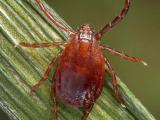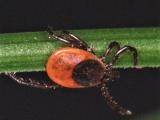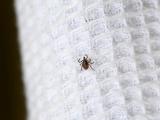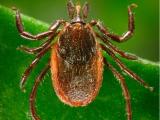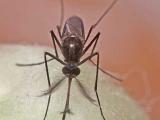In its yearly update on arboviruses (those transmitted by insects and other arthropods), the Centers for Disease Control and Prevention said today that states reported 2,205 cases of West Nile virus (WNV) infection in 2014—many of them severe—and a new report identified 65 previously unreported cases of a new tickborne disease, mostly in Minnesota and Wisconsin.
Previously, only four cases of the new tickborne disease—caused by an Ehrlichia muris–like (EML) bacterium—were detected in Minnesota and Wisconsin in 2009
Most arbovirus cases severe
The CDC received reports on 2,327 cases of notifiable arbovirus disease in 2014, and 1,453 of them (62%) were classified as neuroinvasive disease. By far the most common pathogen was WNV, accounting for 95% of all cases. Other pathogens included La Crosse virus (80 cases), Jamestown Canyon virus (11), St. Louis encephalitis virus (10), Powassan virus (8), Eastern equine encephalitis virus (8), and unspecified California serogroup virus (5).
The results were detailed in today's Morbidity and Mortality Weekly Report (MMWR). Both total arbovirus cases and WNV cases are down a bit from 2013, when 2,605 and 2,469, respectively, were reported.
Forty-six states reported cases last year. The states not reporting cases were Alaska, Delaware, Rhode Island, and Vermont.
As in previous years, the 2,205 WNV cases were seasonal, with 90% occurring July through September. The median age of patients was 57 years, and 72% were hospitalized and 4% (97 patients) died.
Hospitalization rates in those with neuroinvasive WNV disease were considerably higher, at 96%, and 6% (87 patients) died. Of the 1,347 neuroinvasive WNV cases, 620 (46%) were reported as encephalitis, 565 (42%) as meningitis, 132 (10%) as acute flaccid paralysis, and 30 (2%) as other. Of the 132 patients with acute flaccid paralysis, 102 (77%) also had encephalitis or meningitis.
The national incidence of neuroinvasive WNV disease was 0.42 per 100,000 population. States with the highest incidence were Nebraska (2.2 per 100,000), North Dakota (1.6), California (1.4), South Dakota (1.4), Louisiana (1.3), and Arizona (1.2). Three states reported 66% of the neuroinvasive cases: California (561 cases), Texas (253), and Arizona (80).
Impact from other viruses
The 80 La Crosse virus disease cases were in nine states, and 76 (95%) were neuroinvasive and all but one required hospitalization. Incidence for the neuroinvasive form was highest in Ohio, North Carolina, and Tennessee.
Massachusetts, Minnesota, Tennessee, and Wisconsin reported the 11 Jamestown Canyon virus cases in 2014, and 6 were neuroinvasive. Seven patients were hospitalized but none died. Tennessee reported its first-ever case of the disease. In 2013 the CDC reported an all-time high for the disease: 22 cases.
Alabama, Arizona, Florida, Mississippi, and Texas reported the 10 St. Louis encephalitis cases, and 6 were neuroinvasive. The eight Powassan virus cases were in Massachusetts, New Jersey, New York, and Wisconsin, and seven involved the neuroinvasive form. All patients afflicted with these two diseases were hospitalized but none died.
All eight Eastern equine encephalitis virus cases were neuroinvasive and proved the deadliest of the pathogens reported. Cases were confirmed in Alabama, Maine, Michigan, New Hampshire, and New York. All were hospitalized and two died.
The CDC authors conclude, "Arboviruses continue to cause substantial morbidity in the United States, although reported numbers of cases vary annually. Cases occur sporadically, and the epidemiology varies by virus and geographic area. The weather, zoonotic host and vector abundance, and human behavior are all factors that can influence when and where outbreaks occur.
"Because of this complex ecology, it is difficult to predict how many cases of disease might occur in the future and in what areas; therefore, surveillance is essential to identify outbreaks and guide prevention efforts.
"Health care providers should consider arboviral infections in the differential diagnosis of cases of aseptic meningitis and encephalitis, obtain appropriate specimens for laboratory testing, and promptly report cases to public health authorities."
More cases involving novel Ehrlichia
In related news, an analysis of serology samples by CDC and state researchers has confirmed 65 newly reported cases of likely tickborne EML disease in five states, predominantly in Minnesota and Wisconsin, a new study in Emergency Infectious Diseases noted.
Until 2009, the bacteria Ehrlichia chaffeensis and E ewingii were thought to be the only causes of ehrlichiosis in the United States. But that year an Ehrlichia species closely related to E muris was detected in three symptomatic patients in Wisconsin and one in Minnesota. The EML bacterium was also detected in deer ticks in the two states.
The researchers analyzed polymerase chain reaction data from serology testing on 75,077 patients for the EML bacterium from 2004 through 2013 and identified 69 EML cases, including the initial 4.
Cases were in 5 states: Minnesota (33), Wisconsin (31), North Dakota (3), and 1 each in Indiana and Michigan. All 69 patients reported likely tick exposure in Minnesota or Wisconsin.
Patient's median age was 63, and 64% were male. Fever, malaise, thrombocytopenia, and lymphopenia were the most commonly reported symptoms. Sixteen patients (23%) were hospitalized for a median of 4 days. All of them recovered, and all but one received doxycycline.
The authors conclude, "This pathogen should be considered among the differential diagnoses when tickborne diseases are suspected among residents of Minnesota or Wisconsin or among persons with histories of travel to either state."
See also:
Sep 4 MMWR report on arboviruses
Jun 19, 2014, CIDRAP News scan on 2013 arbovirus report
Sep 2 Emerg Infect Dis study on novel Ehrlichia cases



